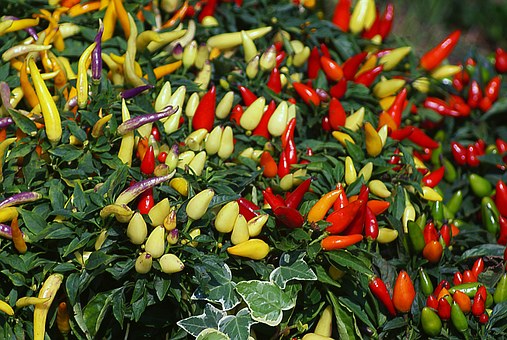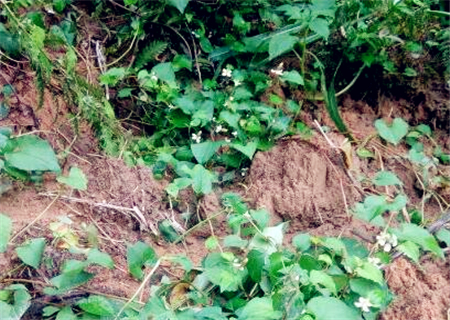Solanaceae plants pepper species what varieties of high yield? What are the key points of planting technology?
Chaotianjiao, also known as Wangtian pepper and small pepper, is a common perennial plant in Yunnan, Guizhou, Sichuan, Shanxi, Guangxi and other places. Because it is smaller than other peppers and full of spicy flavor, it is favored by pepper eaters. At present, many areas are planted. What are the key points of planting technology?

1. Variety selection
Select varieties with high yield, good quality, wide adaptability, disease and insect resistance and good commodity quality.
1. High-quality varieties of clustered pepper
(1)mantianhong
Good disease resistance, wide adaptability. Mid-ripening variety, good fruit shape, 6~8 fruits per cluster, good commodity. The fruit is 6 cm long, 1 - 1.2 cm thick and weighs about 5 grams per fruit. Plant tall, strong branching, disease resistance, high yield.
(2)Shengnong Chaotian No. 2
Good disease resistance, wide adaptability. Early maturing variety, fruit shape is good, each cluster bears 6~8 fruits. High yield, fruit length about 6 cm, thick 0.9~1.1 cm. Peel thin, spicy strong, good commodity quality of fresh fruit, excellent quality of dried fruit.
2. Erect single pepper variety
danfeng Chaoyang
Mid-early maturity, fruit length 5~7 cm, fruit diameter 0.8~1.2 cm, single fruit weight 4~6 grams, high yield. It is a good variety suitable for processing and export, suitable for making green, red and dried peppers. Strong disease resistance, heat resistance, moisture tolerance, high fruit set rate, good commodity quality.
3. Single pepper variety
Shan Feng
Early maturity, strong disease resistance, wide adaptability. Strong growth, long harvest period, high continuous fruit setting rate, high yield. The peel is medium thick, spicy and thick, the dried pepper is dark in color and good in commodity quality. Fruit 5~6 cm long, 0.9~1 cm thick, single fruit weight about 5 grams.
II. Cultivation techniques
1. Seed germination
Before seedling sowing, pepper seeds should be germinated, which can promote pepper seedlings to emerge quickly and evenly and improve the emergence rate. The specific method is as follows: putting the seeds dried in the sun for 1 to 2 days into a cloth bag, soaking the seeds in warm water at 50 to 55 DEG C for 10 to 15 minutes for disinfection, and stirring continuously. After soaking in warm water, the seeds are moved into water at about 30 DEG C, continuously soaked for 12 - 24 hours, then put into a heat preservation container at 20 - 30 DEG C for germination, washed once a day with warm water at about 25 DEG C, turned up and down, germinated for 4 - 5 days, and sown after the seeds are exposed to white.
2. Sowing seedlings
(1)seedbed selection
Select fertile land with flat terrain, ventilated sun, close to water source and loose soil, till 20~30 cm before winter, freeze and sun ripening. However, it is forbidden to continuously crop seedlings in the same piece of land, and the plots with underground pests should be controlled with chemicals. The area of seedbed is determined according to the area planted in the field. Generally, planting 1 mu of pepper requires seedling raising of 15~20 square meters and about 150 grams of seeds.
(2)seedbed preparation
10~15 days before sowing, 5000 kg of fully decomposed high-quality farm manure, 30 kg of calcium superphosphate and 20 kg of urea are applied per mu, and the soil is evenly raked to make the soil and fertilizer mixed evenly, so as to make a flat bed with a width of 1.2~1.5 meters. Nursery beds require flat, ridge straight, soil loose, soil fine without waste.
(3)proper seeding
In the west of Henan Province, sowing is generally carried out in the sunny morning in late February and early March. Before sowing, first irrigate sole water in the border. After the water infiltrates, mix the seeds with 2~3 times of fine soil, mix them evenly and sprinkle them in the nursery bed to restore the sowing several times to ensure uniform sowing. Then cover the fine soil of about 1 cm on it evenly to prevent the seeds from exposing to the ground. After sowing, set up plastic film small arch shed in time or cover film on the built greenhouse in time to prevent freezing and increase temperature.
(4)seedbed management
From sowing to emergence, the ground in the ridge should be kept moist to prevent soil hardening. When the seedlings emerge, they can be watered once to straighten the cotyledons and take root. Keep the temperature of seedbed at 20~30℃ during the day and 15~20℃ at night. Control the temperature in seedbed at no more than 30℃ during the day. In fine weather, proper ventilation and cooling should be carried out to prevent leaf burns; straw curtain should be covered before strong wind and cold current to prevent frostbite seedlings. In order to prevent seedlings from growing wildly and growing into tall seedlings, attention should be paid to timely ventilation and ventilation.
7~10 days before transplanting, gradually increase the vent until the film is exposed to reduce the temperature of the seedbed and strengthen the seedling training to facilitate the slow seedling after transplanting. When the surface of bed soil is dry, choose sunny morning watering to replenish moisture, when the humidity in bed is too large, ventilation and moisture removal.
3. Field planting
(1)field preparation
Chaotianjiao likes to grow stubble land, not continuous cropping, to choose 2~3 years have not planted eggplant vegetables in non-low-lying land, deep ploughing frozen soil before winter. Spring soil preparation should be deeply ploughed and carefully harrowed to achieve fine soil without waste, and the ploughing depth is about 25 cm.
(2)fertilizer
According to the fertilization principle of "combining organic fertilizer with inorganic fertilizer, supplementing nitrogen, phosphorus, potassium and trace fertilizer", the optimized formula fertilization was carried out. Pollution-free production should use high-quality organic fertilizer compost, manure, decomposed human and livestock manure, green manure, decomposed crop straw, cake fertilizer and so on. Fertilizer and microelement fertilizer permitted to be limited include urea, ammonium bicarbonate, ammonium sulfate, phosphate fertilizer (diammonium phosphate, calcium superphosphate, calcium magnesium phosphate, etc.), potassium fertilizer (potassium chloride, potassium sulfate, etc.), zinc (zinc sulfate), boron (borax), etc. Combined with spring soil preparation, phosphorus fertilizer 70 kg, potassium sulfate 25 kg, nitrogen fertilizer 50 kg, soil miscellaneous fertilizer 3000~5000 kg per mu are generally applied. After soil preparation, make ridge in time, wide ridge 60~70 cm, narrow ridge 50 cm, ridge height 10~15 cm, spread plastic film. The soil preparation should be completed 7~10 days before transplanting.
(3)transplanting method
After rain and frost break (middle and late April), transplanting, one ridge and two rows, plant spacing: about 15 cm per plant, about 25 cm per two plants, planting density: 8000~9000 plants/mu per plant, 5000 plants/mu per two plants, breaking film and drilling, transplanting with soil, watering enough water and sealing soil. During transplanting, the diseased seedlings, weak seedlings, miscellaneous seedlings and variant plants are eliminated.
4. Field management
(1)moisture management
After transplanting, no or less watering should be done to improve soil temperature and promote root development. The yield of pepper fruit is mainly concentrated on the lateral branches, so about 20 days after transplantation, it should be picked in time to limit the growth of main stems and promote lateral branches to achieve high yield.
(2)fertilizer management
After pepper fruit setting, gradually increase the amount of watering. If the base fertilizer is insufficient, spray 2%~3% urea solution, 0.3%~0.4% potassium dihydrogen phosphate solution and 0.2% borax solution on the leaves at the early stage of fruit setting, and apply nitrogen, phosphorus, potassium and trace fertilizer outside the roots.
(3)Disease control:
① Anthrax
70% thiophanate-methyl WP 600~800 times solution or 50% polysulfide suspension 600 times solution was sprayed to control anthracnose.
② Epidemic disease, early blight
58% metalaxyl manganese zinc WP 500~700 times solution was used to control blight and early blight.
③ Virus disease
20% virus A 600 times solution or 1.5% Zhibingling 1000 times solution was sprayed to control virus disease.
5. Harvest
The fruits of colorful peppers planted in the open field generally begin to mature in the middle and late August. They should be cut in time to increase their economic benefits. The mature peppers can be listed or hung in a ventilated and dry place to dry them for consumption or sale as commercial peppers.
Time: 2019-04-08 Click:
- Prev

What are the effects and functions of the fern grass? How to breed it? Is it of high medicinal value?
The grass is a kind of traditional Chinese medicine, also known as Selaginella officinalis or Sabina vulgaris, is a perennial fern, the whole plant can be used in medicine, especially high medicinal value, can be used for some common human prevention and diseases. With regard to the efficacy and function of reviving grass, many people are not very clear about how to raise it.
- Next

What are the efficacy, functions and taboos of Houttuynia cordata Thunb (folded ear root)? Can treat hemorrhoids and rhinitis
Houttuynia cordata Thunb is a Chinese herbal medicine, also known as folded ear root. Houttuynia cordata is generally harvested in summer and grows on the edge of the field and on both sides of the road. It has the effect of clearing away heat and detoxification, and it is generally used to make tea in the hometown. So what are the effects, functions and taboos of Houttuynia cordata? Can you treat hemorrhoids, rhinitis and gynecological diseases?
Related
- Fuxing push coffee new agricultural production and marketing class: lack of small-scale processing plants
- Jujube rice field leisure farm deep ploughing Yilan for five years to create a space for organic food and play
- Nongyu Farm-A trial of organic papaya for brave women with advanced technology
- Four points for attention in the prevention and control of diseases and insect pests of edible fungi
- How to add nutrient solution to Edible Fungi
- Is there any good way to control edible fungus mites?
- Open Inoculation Technology of Edible Fungi
- Is there any clever way to use fertilizer for edible fungus in winter?
- What agents are used to kill the pathogens of edible fungi in the mushroom shed?
- Rapid drying of Edible Fungi

